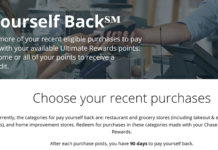NOTICE: This post references card features that have changed, expired, or are not currently available
What’s better, buying points for .5 cents each or for .7 cents each? Obviously .5 is better because it’s cheaper. What if the points in question were Ultimate Rewards points? Same answer, of course. What if you could buy more points at .7 cents each than you could at .5 cents each? Well, then things get interesting…
This line of questioning is driven by the fact that its possible to earn 5 points per dollar when purchasing $200 MasterCard and Visa gift cards at office supply stores by paying with a Chase Ink card. Let’s call this the 5X approach. Similarly, one can earn 2 points per dollar buying $500 MasterCard and Visa gift cards at gas stations by paying with a Chase Ink card. This is the 2X approach.
Assuming the cost to liquidate gift cards is zero, the 5X approach is like buying points for about .7 cents each (due to the card fees), whereas the 2X approach is like buying points for about .5 cents each. At Staples, the 5X approach is improved considerably by enrolling in Visa Savings Edge which can give you an extra 1% cash back, but let’s leave that off the table for the sake of this discussion. Also, for the sake of argument, let’s assume that its equally easy to deal with $200 cards and $500 cards. That’s obviously not true, but it is a useful assumption for simplifying the argument to be made here.
Given the price points I quoted about, it appears that buying $500 gift cards at gas stations (the 2X approach) is a much better solution. And, for those with an unlimited ability to cash out gift cards with no fee, that’s true. What if you have a limit, though?
Assuming $10K limit
Let’s assume that you are limited to making use of $10,000 in gift cards in whatever unit of time you’re comfortable with: 1 week, 1 month, 1 quarter, whatever. Then, we can do the math to see which approach is really better:
5X approach: office supply $200 cards
- 50 cards
- Total fees: 50 x $6.95 = $348
- Total points earned: $10,348 x 5 = 51,740
- Cost per point: .67 cents
2X approach: gas station $500 cards
- 20 cards
- Total fees: 20 x $4.95 = $99
- Total points earned: $10,099 x 2 = 20,198
- Cost per point: .49 cents
When paying more per point is better
To some, it may still look like the 2X approach is better. After all, you would have paid only $99 in fees vs. $348. And, as a result, your cost per point would be only .49 cents vs. .67 cents. On the other hand, the 5X approach results in over 2.5 times more points.
Keep in mind that Ultimate Rewards points are worth a minimum of 1 cent each since they can be traded in for cash. So, the 5X approach is not really more expensive since we can pay ourselves back in points. In fact, with the $200 gift card scenario, we could cash in $249 worth of points to leave us with a total expense of $99 and still have 26,840 points remaining. Now, we have the same overall cost as the gas station approach, but by cashing in some of our points we’ve lowered our cost per point to only .37 cents each.
We could take it even further and cash in enough points to fully pay ourselves back for all fees such that we now have purchased points for free. You can do the same with the 2X approach, but you’ll still have more points remaining with the 5X approach.
By selectively cashing in points, the 5X approach results in more points earned than the 2X approach. The 5X approach, therefore, is better (aside from the pain in the butt of dealing with many more gift cards).
Why I care
Often, when evaluating a deal involving earning points by buying gift cards or reload cards, it is convenient to calculate the cost per point to determine how good of a deal it really is. As I’ve shown here, though, that cost per point calculation can be deceiving. An approach with a higher per point cost can be better under certain circumstances.
The key is that Ultimate Rewards points can be cashed in for a penny each. So, anytime you have the opportunity to buy Ultimate Rewards points for less than a penny, you should take it. When faced with choosing between different price points (all below 1 cent per point), its important to look not just at the cost per point as the deciding factor, but also the number of points that can be purchased with either approach. Let’s take an extreme example: suppose you can choose to buy 1000 points for only one tenth of a cent each or to buy a million points for half a cent each. In the latter case, you would come out way ahead despite the much higher cost per point.





[…] people is to buy $200 Visa or MasterCard gift cards at Staples with a Chase Ink card. This is still lucrative, but not nearly as great as the Office Depot approach used to be. And, dealing with many $200 […]
oh and my math uses a Starwood 1.25 factor on the AMEX GCs………
@Jonathan now clear…..that would never be a good option I think…….
I just ran the AMEX gift card numbers at 2.5% versus buying the Visa GC at Staples to use on your jungle payment account………the Visa GC costs .47 cents a mile while the AMEX option gives you 2 cents a mile so the difference going to Staples is causing you a net expense of 2.47 cents per mile………long term that just won’t do and if it wasn’t for FM zany math posts we would never think of these nuances……….Doctoral level MS seminar I do believe…………
Nice analysis! I think CPP is still the valid metric to go by though, simply because most people arent going to redeem for cash back. In our crazy points collecting world, redeeming ur points at 1cpm is a “god forbid absolute atrocity”, to put it lightly. 🙂
yes Jonathan that is “mostly” true but what about that Relais and Chateau in Normandy because there are no chains to redeem……at that point the Barclay’s 2.2 seems like the only answer in that situation…….what am I missing?
@JustSaying I was referring to U.R. points. I just say ur points so I can see why that wasn’t clear.
And starting July 1 you will have $1500 to spend 5X at gas stations…..$3000 5X his/her accounts so another way to move that needle…………
@Tyler if you will take your meds and play nice I’m sure one of the kind souls on this blog will take you under their wing and show you the proper stroll into the Park Hyatt Vendome………..
but what if you can’t cash out at WM- as of today, no vanillas are working at all- except possibly if doing 99.90 per swipe. Has WM instituted a max swipe of 99.99 for vanilla?
Valuations aside, 5X is greater than 2X and should be the better deal unless the variable fees overwhelm the difference.
No, this is just another example of how bloggers are dishonest and self-serving.
Go ahead and try this for a few months and see what happens. Spoiler alert: Chase has and does blacklist users who are blatantly abusing the system – that big stash of ill-gained UR points clawed back, accounts closed, and persona non grata at Chase going forward.
Some idiot in the circles-and-arows club will follow your advice and get burned. BUt that’s OK, because all that matters to bloggers is that they continue to receive their fat referral fees from all the rubes that blindly sign up for credit cards using their links.
Love the Hate!!
Tyler, are you high?
This is another example of why you are the Elon Musk of Points/Miles!
I would also caveat the assumption that both scenarios are equally obtainable. $200 VGCs purchasable on CC at office supply stores are like candy, and at gas stations they have become pretty much non-existant, unless you have a 7-Eleven around.
Interesting! Just to apply a bit of capital budgeting, the two gc purchase scenarios are essentially two mutually exclusive projects. The cost of point evaluation is similar to the IRR approach, while redeeming points for cash is more of an NPV approach. For mutually exclusive projects, NPV is the preferred way to go.
In fact if we push the latter argument to the extreme and redeem points to cover the fees incurred, we will have about 17000 points vs. 10300 points left respectively.
Interesting thought process. When also factoring in the UR portal bonus, the decision tilts more to 5X. Staples through UR is currently 2X which makes the decision clear.
Another factor is that the 2X requires you to go buy them, the portal happens from home.
For Afam-DFW, re. the URMall cashback, can you confirm that still works for Staples, that you’ll get the extra 2 pts/$ even when buying the visa gift cards?
Can’t confirm or deny right now. My order arrived a week ago but the confirmations usually take a while. At this point, YMMV but I will post if a confirm comes.
Err “fee-based” above should read “fee-free”
I prefer the metric of Profit per Thousand (PPT) dollars of cards bought. You put a dollar value on all points generated, add rebates like VSE, and subtract all costs.
I also like to calculate PPT per trip, where I take into account how many errands I need to do for the full load/drain cycle. A trip is a visit to Walmart, an ATM, Target, bank, etc.
This allows you to see how higher fees with OneVanilla at CVS but with the ability to buy $5k at a time can beat a fee-based ReloadIt to TMo if your supermarket limits you to $500 at a time.
Silly math. The right answer is: do both.
hah.
I agree Eugene.
From post: “Let’s assume that you are limited to making use of $10,000 in gift cards…”
per day?
per month?
either way, you’ve reached the 50k limit on spending on Ink card for bonus categories.
if it’s a limit of 10k/year or 10k ever, then sure. But if you do 10k per month, you’ll more than max this out on the cards used in this post.
@Steve I think we would assume that you have at least two of the Ink cards…..both the Bold and the Plus which will give you 100k of headroom and translate into 500k per year….that would give 20 nights at the top Park Hyatt……..assuming sign up bonus is calculated in………great post BTW………